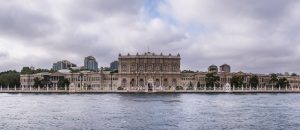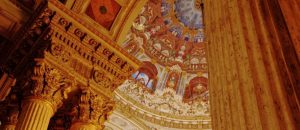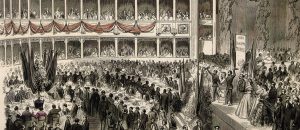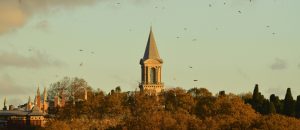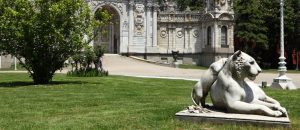The gardens of Dolmabahçe Palace are not just landscape arrangements; they are a green manifesto of the radical revolution in the Ottoman Empire’s perspective on nature and the concept of “paradise”. Unlike the organic and functional garden approach of Topkapı Palace, which was integrated with nature, Dolmabahçe’s symmetrical and geometrical gardens, which appear as if drawn with a ruler, show that Westernization fundamentally changed not only buildings but also the way nature was perceived. This is the story of the transition from living within nature to ruling over nature. [Link: The palace’s general architectural vision -> /explore/grand-design-architecture]
Topkapı’s ‘Paradise’: A Natural and Functional Understanding
The gardens of Topkapı Palace represent an organic concept of ‘paradise’ where nature is left to its own flow, bearing the traces of a functional and nomadic culture. Inspired by the descriptions of paradise in the Quran, aesthetics are combined with function in these gardens. Fruit trees, medicinal herbs, and colorful flowers exist together in a planned chaos. Shady areas, fountains (şadırvanlar) and pools offering the coolness of water, are central to the garden. These are living and breathing spaces where you can enter and get lost, encountering a different surprise in every corner.
In this understanding at Topkapı, man is a part of nature. The garden does not rule over man; man takes refuge in the shade, water, and fruit offered by the garden. The scattering of independent kiosks (köşkler) within this organic landscape is also a reflection of this philosophy. This is a worldview in harmony with nature, one that does not attempt to control it. [Link: A resource on Islamic garden art and the concept of paradise -> https://www.metmuseum.org/toah/hd/igar/hd_igar.htm]
Dolmabahçe’s Rational Nature: Symmetry and Control
Dolmabahçe’s gardens, on the other hand, reflect a rational landscape approach, inspired by Western, and especially French, garden art, which brings nature under control, featuring symmetrical and geometrical arrangements as if drawn with a ruler. Here, the wild and organic flow of nature is not permitted; instead, human intellect and will are used to force nature into a specific aesthetic mold. These gardens are an adaptation of the landscape philosophy of the Palace of Versailles to the Bosphorus, symbolizing the modern, centralist state’s dominance over nature.
The fundamental features of this new approach are:
- Symmetry: Every element in the garden is placed symmetrically according to a main axis. Paths, pools, and flowerbeds are in perfect balance.
- Geometry: The flowerbeds (parterres) are arranged to form clear geometrical patterns such as squares, circles, and rectangles.
- Control: Trees and shrubs are pruned into specific forms, paths extend in straight lines, and everything is part of a design devised by man.
Hasbahçe (The Private Garden): The Empire’s New Showcase
The Hasbahçe, which is the largest garden of Dolmabahçe and located in front of the Selamlık section, was designed as the palace’s sea-facing showcase and is the area where the European-style landscape arrangement is most clearly visible. The large swan pond in the middle forms the center of the garden’s symmetry. The paths and geometrically patterned flowerbeds around the pool are in complete harmony with the palace’s Neoclassical facade. This garden was not designed to be entered and lost in, but to be observed from a specific point to appreciate the order and rationality of the palace and the empire. This is a landscape design serving [Link: The palace’s message to Europe -> /mermerden-daha-fazlasi-dolmabahce-mimarisi-neden-avrupaya-gonderilmis-bir-mesajdi].
Kuşluk Garden (Birdhouse Garden): A Transition Between Tradition and Modernity
The Kuşluk Garden, located behind the Harem section of the palace and named after a historical birdhouse, has a smaller and more intimate character compared to the Hasbahçe. Although the geometric arrangement continues here, with the use of different plant species such as camellia and magnolia and its more sheltered structure, it is closer to the traditional Ottoman gardens’ search for shade and privacy. This garden can be seen as the product of a search for a synthesis between the old and the new, rather than a complete break.
Power Over Nature: A Revolution of Mentality
The fundamental difference between the Topkapı and Dolmabahçe gardens reflects a radical revolution of mentality regarding the relationship between man and nature, going beyond a mere shift in aesthetic taste. While the Topkapı garden represents man’s place within nature, the Dolmabahçe garden declares man’s power over nature. The former symbolizes harmony and submission, while the latter symbolizes reason, control, and dominion. This is the reflection of the rationalist philosophy of the Age of Enlightenment and the modern state’s desire to regulate and control everything, mirrored in landscape architecture.
Conclusion
In conclusion, the gardens of Dolmabahçe Palace have fundamentally changed the Ottoman understanding of “paradise”. The traditional, organic, and functional idea of the paradise garden has been replaced by a symmetrical, geometric, and rational landscape where human intellect rules over nature. This change is the most vivid proof of how deep a transformation Westernization created, not only in stone and marble but also in the perspective towards soil and plants. Wandering through the gardens of Dolmabahçe is therefore not just looking at beautiful flowers, but also tracing the footsteps of a civilization’s new relationship with nature.










